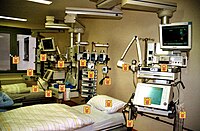
Photo from wikipedia
Objectives: To identify patient and healthcare worker factors associated with transmission risk of Acinetobacter baumannii during patient care. Design: Prospective cohort study. Setting: ICUs at a tertiary care medical center.… Click to show full abstract
Objectives: To identify patient and healthcare worker factors associated with transmission risk of Acinetobacter baumannii during patient care. Design: Prospective cohort study. Setting: ICUs at a tertiary care medical center. Patients: Adult ICU patients known to be infected or colonized with A. baumannii. Measurements and Main Results: Cultures of skin, respiratory tract, and the perianal area were obtained from participants and evaluated for the presence of A. baumannii. Healthcare worker-patient interactions were observed (up to five interactions/patient) and activities were recorded. Healthcare worker hands/gloves were sampled at room exit (prior to hand hygiene or glove removal) and then evaluated for the presence of A. baumannii. Two hundred fifty-four healthcare worker-patient interactions were observed among 52 patients; A. baumannii was identified from healthcare worker hands or gloves in 77 (30%) interactions. In multivariate analysis, multidrug-resistant A. baumannii (odds ratio, 4.78; 95% CI, 2.14–18.45) and specific healthcare worker activities (touching the bed rail [odds ratio, 2.19; 95% CI, 1.00–4.82], performing a wound dressing [odds ratio, 8.35; 95% CI, 2.07–33.63] and interacting with the endotracheal tube or tracheotomy site [odds ratio, 5.15; 95% CI, 2.10–12.60]), were associated with hand/glove contamination. Conclusions: Healthcare worker hands/gloves are frequently contaminated with A. baumannii after patient care. Patient-level factors were not associated with an increased transmission risk; however, having multidrug-resistant-A. baumannii and specific healthcare worker activities led to an increased contamination risk. Our findings reveal a potential selective advantage possessed by multidrug-resistant-A. baumannii in this environment and suggest possible areas for future research.
Journal Title: Critical Care Medicine
Year Published: 2017
Link to full text (if available)
Share on Social Media: Sign Up to like & get
recommendations!